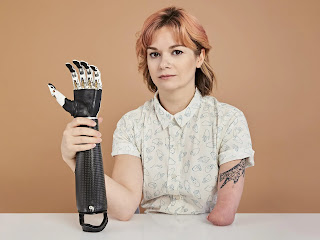Cyborg
Human Cyborgization: the latest technology and the top of real cyborgs. Cyborgs are already among us. The technology of the future is already here today. Are we already cyborgs? In this present selected current progress and perspectives on the process of cyborgization.
What is a cyborg: It is person whose physical abilities are extended beyond normal human limitations by mechanical elements built into the body.
Cyborgization is fashion, madness or a natural part of our evolution? What technological discoveries can make cyborgization a part of evolution, and what opportunities does merging with a machine give man? Look at the real cyborgs and the latest technology 2020 to turn humans into cyborgs.
Is biohacking closely related to cyborgisation?An incredible speed and 3D printing has made bionic body parts relatively accessible as well. But the real evolution in cybe organization was the new technology discovered 2019 year by researchers at MIT. It allows you to feel the robotic body part like on real life, not just giving feedback, but also feeling the position of the prosthesis in space. In space, the neuro embodied design project is led by Professor Hugh her at MIT
who himself has lost both his legs under his leadership and agnostic anti gnostic bonero interface was developed, abbreviated AM I, which connects the nerves in the residual limb to the external bionic prosthesis and allows you to feel it as a full body heart. It is this feeling of unity with its means of rehabilitation, the boundary that turns a man into a cyborg, the professor believes the new neural interface and communication paradigm are able to send movement commands from the central nervous system to the robotic prosthesis and transmit proprioceptive feedback describing the joint movement back to the central nervous system.
The technology also includes a special surgical technique that closes each muscle pair of an agonist. Interestingly, Hugh Herr sees the application of Technology, not only for rehabilitation, but also for the empowerment of the individual. For example, to create real wings, which the carrier The idea of empowering the human being with advanced prosthesis is not new. For example, Jane Young, having lost his hand, developed together with the Japanese company Konami Bionican on the model of his favorite computer game, metal gear solid. The hand includes its own drone, the lighting of which James can change accordingly to his mood, laser flashlight, USB port for charging the phone, sports watches and, most importantly, the hand itself, which responds to messages sent by his muscles. Drummer Jason Barnes all the solo lost his hand, but did not part with his muscular career. His pro ceases has two built-in drumsticks, one of which is controlled by a sensor that reads the electromyogram from the muscle, and the other is controlled by an artificial intelligence and improvised, adjusting to the first stick. The beat rate allows James to be the fastest drummer in the world at 20 beats per second. Jason also has a single stick pro seasons and a bionic hand that allows him to learn to play the piano. Rob Spence is a director with the cybernetic eye that records everything he sees to realize the idea we had to place a wireless camera in the cavity with a 9 by 30 by 28 millimeter parameters.
As a result, the former employee of MIT and spacex engineer coast of Grammatis was able to literally squeeze in eight square millimeters, not only the camera itself, but also the battery with a signal transmitter to an external device as well as a board for image processing. The charge of such a camera is only enough In other countries like Russia, cyborgization is moving forward. The most advanced bionic prosthesis are made by Max Bionic, which specializes in hand and Morotica, which creates a highly functional prosthesis for adults and children. But it's not just by wearing the prosthesis that you can become a cyborg.
The next level is to introduce chips into the brain or the head or the spinal cord. Such implants allow you to move and feel the world with paralyzed limbs, replacing the missing feelings of nature and create new ones. And that is not fantastic. The first paralyzed person who was able to move his limbs again was Ian Burkhardt, who broke his neck at the age of 19. Scientists took a functional magnetic resonance image of Ian's brain while he focused on a video of his hand movements and identified the responsible part of his motor cortex. It was implanted with a chip that reads the activity of the area of the brain converting and transmitting the signal through a cable to a computer. This information is then sent as an electrical signal to the flexible sleep around the subject's right arm, and it stimulates the muscles.
Recently, American scientists created a neural interface that allowed a patient with spinal cord injuries to not only control the movements of his paralyzed hand, but also to feel the grip and regulate its power. Weak residual sensory sensitivity was found in the primary motor cortex in his enhanced by a feedback system. Brain implantation can also change perception of reality. In 2003, Neil Harbison was implanted with a sensor in his head that allows him to hear color by determining the frequency of the color in front of him, translating it into sound and transmitting sound through bone conduction to his brain. Harperson says that this connection between color and sound soon became a perception, allowing him to dream about color. And at this point, he feels that software and his brain have merged. Besides the normal spectrum, harvesting can also proceed infrared and ultraviolet light. But most engineers see the ultimate goal of brain implants, not in return of the lost feelings and abilities, but empowering the brain by connecting it to a computer, merging with artificial intelligence. The most famous project in this area is Elon Musk's neurolink company.
Neuroling for a more precisely neural lace technology consists of a nanogrid of electrodes that integrate with the brain, allowing it to transmit and receive digital information directly in the future. This will greatly expand the capabilities of the brain, but will people want to version the inserted chip into their brains. The issue of potential voluntary cyborgization bases several challenges, from fears that this technology empowerment will only be available to the elite and to the horrors of the thought of an army of cyborgs. What do you think of the potential for cyborgization?
Tags
Cyborg








